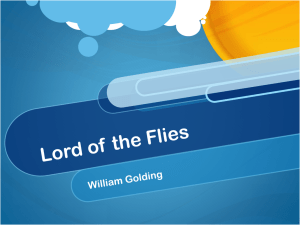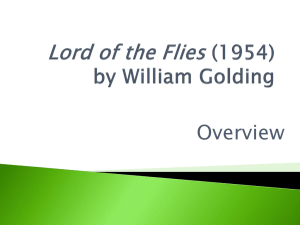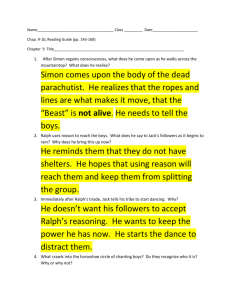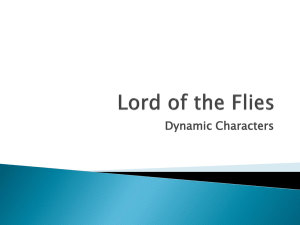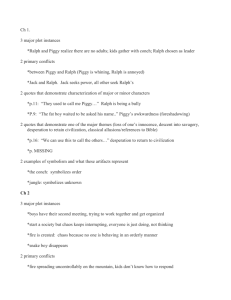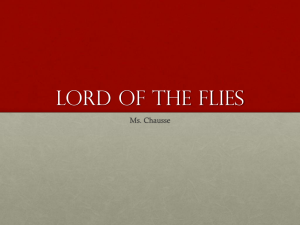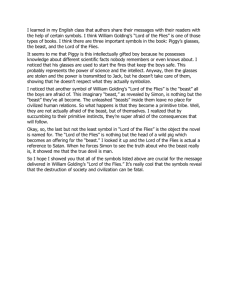A Psychological Analysis of William Golding`s `Lord of
advertisement
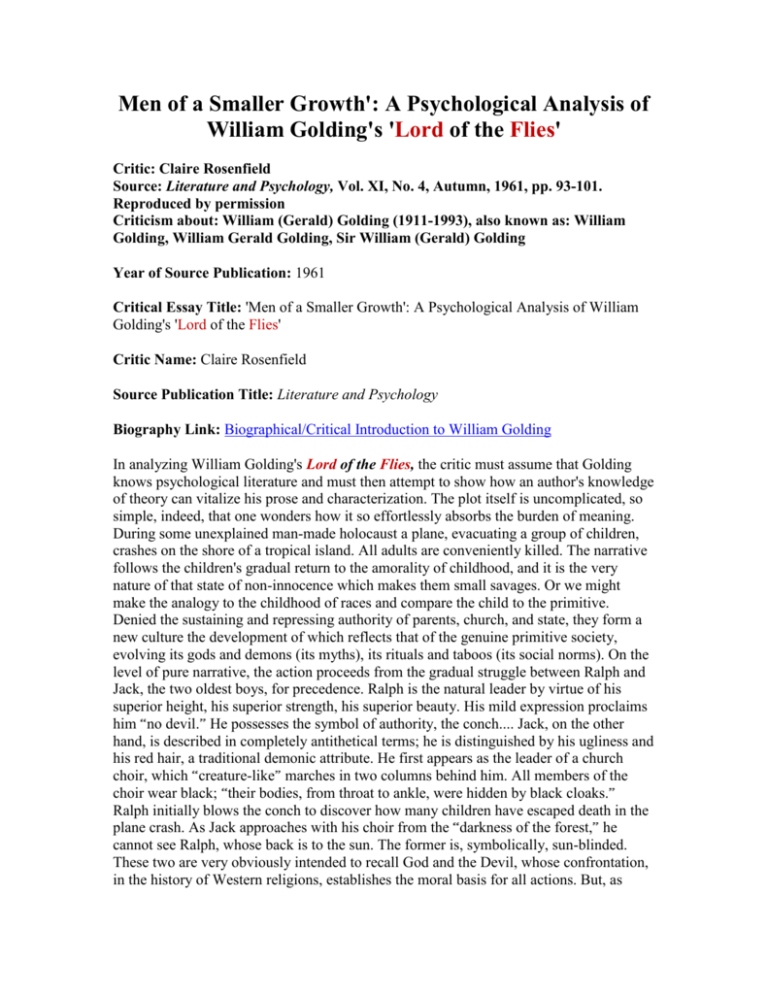
Men of a Smaller Growth': A Psychological Analysis of William Golding's 'Lord of the Flies' Critic: Claire Rosenfield Source: Literature and Psychology, Vol. XI, No. 4, Autumn, 1961, pp. 93-101. Reproduced by permission Criticism about: William (Gerald) Golding (1911-1993), also known as: William Golding, William Gerald Golding, Sir William (Gerald) Golding Year of Source Publication: 1961 Critical Essay Title: 'Men of a Smaller Growth': A Psychological Analysis of William Golding's 'Lord of the Flies' Critic Name: Claire Rosenfield Source Publication Title: Literature and Psychology Biography Link: Biographical/Critical Introduction to William Golding In analyzing William Golding's Lord of the Flies, the critic must assume that Golding knows psychological literature and must then attempt to show how an author's knowledge of theory can vitalize his prose and characterization. The plot itself is uncomplicated, so simple, indeed, that one wonders how it so effortlessly absorbs the burden of meaning. During some unexplained man-made holocaust a plane, evacuating a group of children, crashes on the shore of a tropical island. All adults are conveniently killed. The narrative follows the children's gradual return to the amorality of childhood, and it is the very nature of that state of non-innocence which makes them small savages. Or we might make the analogy to the childhood of races and compare the child to the primitive. Denied the sustaining and repressing authority of parents, church, and state, they form a new culture the development of which reflects that of the genuine primitive society, evolving its gods and demons (its myths), its rituals and taboos (its social norms). On the level of pure narrative, the action proceeds from the gradual struggle between Ralph and Jack, the two oldest boys, for precedence. Ralph is the natural leader by virtue of his superior height, his superior strength, his superior beauty. His mild expression proclaims him no devil. He possesses the symbol of authority, the conch.... Jack, on the other hand, is described in completely antithetical terms; he is distinguished by his ugliness and his red hair, a traditional demonic attribute. He first appears as the leader of a church choir, which creature-like marches in two columns behind him. All members of the choir wear black; their bodies, from throat to ankle, were hidden by black cloaks. Ralph initially blows the conch to discover how many children have escaped death in the plane crash. As Jack approaches with his choir from the darkness of the forest, he cannot see Ralph, whose back is to the sun. The former is, symbolically, sun-blinded. These two are very obviously intended to recall God and the Devil, whose confrontation, in the history of Western religions, establishes the moral basis for all actions. But, as Freud reminds us ...~, gods and devils are nothing other than psychological processes projected into the outer world. If Ralph is a projection of man's good impulses from which we derive the authority figures whether god, king, or father who establish the necessity for our valid ethical and social action, then Jack becomes an externalization of the evil instinctual forces of the unconscious. Originally, as in the more primitive religions, gods and devils were one; even Hebraic-Christian tradition makes Satan a fallen angel. The temptation is to regard the island on which the children are marooned as a kind of Eden, uncorrupted and Eveless. But the actions of the children negate any assumption about childhood innocence. Even though Golding himself momentarily becomes a victim of his Western culture and states that Ralph wept for the end of innocence, events have simply supported Freud's conclusions that no child is innocent. On a third level, Ralph is every man or every child and his body becomes the battleground where reason and instinct struggle, each to assert itself. For to regard Ralph and Jack as Good and Evil is to ignore the role of the child Piggy, who in the child's world of make-believe is the outsider. Piggy's composite description not only manifests his difference from the other boys; it also reminds the reader of the stereotype image of the old man who has morethan-human wisdom: he is fat, inactive because asthmatic, and generally reveals a disinclination for physical labor. Because he is extremely near-sighted, he wears thick glasses a further mark of his difference. As time passes, the hair of the other boys grows with abandon. He was the only boy on the island whose hair never seemed to grow. The rest were shock-headed, but Piggy's hair still lay in wisps over his head as though baldness were his natural state, and this imperfect covering would soon go, like the velvet on a young stag's antlers. In these images of age and authority we have a figure reminiscent of the children's past the father. Moreover, like the father he counsels common sense; he alone leavens with a reasonable gravity the constant exuberance of the others for play or for play at hunting. When they scamper off at every vague whim, he scornfully comments, Like a pack of kids. Ungrammatically but logically, he tries to allay the littluns fear of a beast. ... He has excessive regard for the forms of order: the conch must be held by a child before that child can speak at councils. When the others neglect responsibility, fail to build shelters, swim in the pools or play in the sand or hunt, allow the signal fire on the mountain to go out or to get out of hand and burn up half the island, he seconds Ralph by admonishing the others vigorously and becomes more and more of a spoil-sport who robs play of its illusions, the adult interrupting the game. Ralph alone recognizes his superior intelligence but wavers between what he knows to be wise and the group acceptance his egocentricity demands. Finally, Piggy's role as man's reasoning faculties and as a father derives some of its complexity from the fact that the fire which the children foster and guard on the mountain in the hope of communicating with the adult world is lighted with his glasses. In mythology, after all, the theft of fire brought civilization and, hence, repression to man. As the new community becomes more and more irrational, its irrationality is marked by Piggy's progressive blindness. (pp. 93-4) The history of the child Piggy on the island dramatizes in terms of the individual the history of the entire group. When they first assemble to investigate their plight, they treat their island isolation as a temporary phenomenon; they want to play games until they are rescued until their parents reassert the repressive actions of authority. This microcosm of the great world seems to them to be a fairy land.... They compare this reality to their reading experiences: it is Treasure Island or Coral Island or like pictures from their travel books. This initial reaction conforms to the pattern of play which Johan Huizinga establishes in Homo Ludens. In its early stages their play has no cultural or moral function; it is simply a stepping out of real life into a temporary sphere of activity. Ironically, the child of Lord of the Flies who thinks he is only pretending or that this is only for fun does not realize that his play is the beginning of the formation of a new society which has regressed to a primitive state, with all its emphasis upon taboo and communal action. What begins by being like other games in having a distinct locality and duration apart from ordinary life is or becomes reality. (pp. 94-5) The games of the beginning have a double function: they, first of all, reflect the child's attitude toward play as a temporary cessation from the activities imposed by the adult world; but like the games played before the formation of civilization, they anticipate the ritual which reveals a developing society. So the children move from voluntary play to ritual, from only pretending to reality, from representation to identification. The older strictures imposed by parents are soon forgotten but every now and then a momentary remembrance of past prohibitions causes restraint. (p. 95) The younger children first, then gradually the older ones, like primitives in the childhood of races, begin to people the darkness of night and forest with spirits and demons which had previously appeared only in their dreams or fairy tales. Now there are no comforting mothers to dispel the terrors of the unknown. They externalize these fears into the figure of a beast. Once the word beast is mentioned, the menace of the irrational becomes overt; name and thing become one. At one critical council when the first communal feeling begins to disintegrate, Ralph cries, 'If only they could send us something grownup ... a sign or something.' And a sign does come from the outside. That night, unknown to the children, a plane is shot down and its pilot parachutes dead to earth and is caught in the rocks on the mountain. It requires no more than the darkness of night together with the shadows of the forest vibrating in the signal fire to distort the hanging corpse with its expanding silk 'chute into a demon that must be appeased. Ironically, the fire of communication does touch this object of the grown-up world only to foster superstition. Security in this new situation can be achieved only by establishing new rules. During the first days the children, led by Jack, play at hunting. But eventually the circle of the playground extends to the circle of the hunted and squealing pig seeking refuge and it is significant that the first animal slain for food is a nur-sing sow which itself anticipates the circle of consecrated ground where the children perform the new rites of the kill. The first hunt accomplishes its purpose: the blood of the animals is spilled; the meat, used for food. But because Jack and his choir undertake this hunt, they desert the signal fire, which is dictated by the common-sense desire for rescue, and it goes out and a ship passes the island. Later the children reenact the killing with one boy, Maurice, assuming the role of the pig running its frenzied circle. The others chant in unison: 'Kill the pig. Cut her throat. Bash her in.' At this dramatic representation each child is still aware that this is a display, a performance. He is never so beside himself that he loses consciousness of ordinary reality. Each time they reenact the same event, however, their behavior becomes more frenzied, more cruel, less like representation than identification. The chant then becomes, 'Kill the beast. Cut his throat. Spill his blood.' It is as if the first event, the pig's death, is forgotten in the recesses of time; a new myth defines the primal act. Real pig becomes mythical beast. Jack's ascendancy over the group begins when the children's fears distort the natural objects around them: twigs become creepers, shadows become demons. I have already discussed the visual imagery suggesting Jack's demonic function. He serves as a physical manifestation of irrational forces. After an indefinite passage of time, he appears almost dehumanized, his nose only a few inches from the humid earth. He is dog-like and proceeds forward on all fours into the semi-darkness of the undergrowth. ... Already he has begun to obliterate the distinctions between animals and men, as do primitives; already he thinks in terms of the metaphor of a ritual drinking of blood, the efficacy of which depended on the drinker's assumption of his victim's strength and spirit. Ralph and Piggy confront him with his defection of duty. The two boys faced each other. There was the brilliant world of hunting, tactics, fierce exhilaration, skill; and there was the world of longing and baffled commonsense. Jack transferred the knife to his left hand and smudged blood over his forehead as he pushed down the plastered hair. Jack's unconscious gesture is a parody of the ritual of initiation in which the hunter's face is smeared with the blood of his first kill. In the subsequent struggle one of the lenses of Piggy's spectacles is broken. The dominance of reason is over; the voice of the old world is stilled. The primary images are no longer those of fire and light but those of darkness and blood. The link between Ralph and Jack had snapped and fastened elsewhere. The rest of the group, however, shifts its allegiance to Jack because he has given them meat rather than something useless like fire. Gradually, they begin to be described as shadows or masks or savages or demoniac figures and, like Jack, hunt naked save for paint and a belt. Ralph now uses Jack's name with the recognition that a taboo was evolving around that word too. Name and thing again become one; to use the word is to incite the bearer. But more significant, the taboo, according to Freud, is a very primitive prohibition imposed from without (by an authority) and directed against the strongest desires of man. In this new society it replaces the authority of the parents. Now every kill becomes a sexual act, is a metaphor for childhood sexuality.... Every subsequent need for ritual fulfills not only the desire for communication and a substitute security to replace that of civilization, but also the need to liberate both the repressions of the past and those imposed by Ralph. Indeed, the projection of those impulses that they cannot accept in themselves into a beast is the beginning of a new mythology. The earlier dreams and nightmares can now be shared as the former subjectivity could not be. When the imaginary demons become defined by the rotting corpse and floating 'chute on the mountain which their terror distorts into a beast, Jack wants to track the creature down. After the next kill, the head of the pig is placed upon a stake to placate it. Finally one of the children, Simon, after an epileptic fit, creeps out of the forest at twilight while the others are engaged in enthusiastic dancing following a hunt. Seized by the rapture of reenactment or perhaps terrorized by fear and night into believing that this little creature is a beast, they circle Simon, pounce on him, bite and tear his body to death. He becomes not a substitute for beast but beast itself; representation becomes absolute identification, the mystic repetition of the initial event. (pp. 95-7) Simon's mythic and psychological role has earlier been suggested. Undersized, subject to epileptic fits, bright-eyed, and introverted, he constantly creeps away from the others to meditate among the intricate vines of the forest. To him, as to the mystic, superior knowledge is given intuitively which he cannot communicate. When the first report of the beast-pilot reaches camp, Simon, we are told, can picture only a human at once heroic and sick. During the day preceding his death, he walks vaguely away and stumbles upon the pig's head left in the sand in order to appease the demonic forces they imagine. Shaman-like, he holds a silent colloquy with it, a severed head covered with innumerable flies. It is itself the titled Lord of the Flies, a name applied to the Biblical demon Beelzebub and later used in Goethe's Faust, Part I, to describe Mephistopheles. From it he learns that it is the Beast, and the Beast cannot be hunted because it is within. Simon feels the advent of one of his fits and imagines the head expanding, an anticipation or intuition of the discovery of the pilot's corpse. Suddenly Golding employs a startling image, Simon was inside the mouth. He fell down and lost consciousness. Literally, this image presents the hallucination of a sensitive child about to lose control of his rational faculties. Metaphorically, it suggests the ritual quest in which the hero is swallowed by a serpent or dragon or beast whose belly is the underworld, undergoes a symbolic death in order to gain the elixir to revitalize his stricken society, and returns with his knowledge to the timed world as a redeemer. Psychologically, this narrative pattern is a figure of speech connoting the annihilation of the ego, an internal journey necessary for self-understanding, a return to the timelessness of the unconscious. When Simon wakes, he realizes that he must confront the beast on the mountain because what else is there to do? He is relieved of that dreadful feeling of the pressure of personality which had oppressed him earlier. When he discovers the hanging corpse, he first frees it in compassion although it is rotting and surrounded by flies, and then staggers unevenly down to report to the others. Redeemer and scapegoat, he becomes the victim of the group he seeks to enlighten. In death before he is pulled into the sea his head is surrounded by flies in an ironic parody of the halo of saints and gods. Piggy's death, soon to follow Simon's, is foreshadowed when the former proclaims at council that there is no beast. 'What would a beast eat?' 'Pig.' 'We eat pig,' he rationally answers. 'Piggy!' is the next word. At Piggy's death his body twitches like a pig's after it has been killed. Not only has his head been smashed, but also the conch, symbol of order, is simultaneously broken. A complex group of metaphors unite to form a total metaphor involving Piggy and the pig, hunted and eaten by the children, and the pig's head which is at once left to appease the beast's hunger and is the beast itself. But the beast is within, and the children are defined by the very objects they seek to destroy. In these associated images we have the whole idea of a communal and sacrificial feast and a symbolic cannibalism, all of which Freud discussed in Totem and Taboo. Here the psychology of the individual contributes the configurations for the development of religion. Indeed, the events of Lord of the Flies imaginatively parallel the patterns which Freud detects in primitive mental processes. Having populated the outside world with demons and spirits which are projections of their instinctual nature, these children and primitive men must then unconsciously evolve new forms of worship and laws, which manifest themselves in taboos, the oldest form of social repression. With the exception of the first kill in which the children still imagine they are playing at hunting the subsequent deaths assume a ritual form; the pig is eaten communally by all and the head is left for the beast, whose role consists in sharing the feast. This is much like the public ceremony described by Freud in which the sacrifice of an animal provided food for the god and his worshippers.... So we see that, as Freud points out, the sacrificing community, its god [the 'beast'], and the sacrificial animal are of the same blood, members of a clan. The pig, then, may be regarded as a totem animal, an ancestor, a tutelary spirit and protector ; it is, in any case, a part of every child. The taboo or prohibition against eating particular parts of the totem animal coincides with the children's failure to eat the head of the pig. It is that portion which is set aside for the beast. Just as Freud describes the primitive feast, so the children's festive meal is accompanied by a frenzied ritual in which they temporarily release their forbidden impulses and represent the kill. To consume the pig and to reenact the event is not only to assert a common identity but also to share a common responsibility for the deed. None of the boys is excluded from the feast. The later ritual, in which Simon, as a human substitute identified with the totem, is killed, is in this novel less an unconscious attempt to share the responsibility for the killing of a primal father in prehistoric times, than it is a social act in which the participants celebrate their new society by commemorating their severance from the authority of the civilized state. Because of the juxtaposition of Piggy and pig, the eating of pig at the communal feast might be regarded as the symbolic cannibalism by which the children physically partake of the qualities of the slain and share responsibility for their crime. (It must be remembered that, although Piggy on a symbolic level represents the light of reason and the authority of the father, on the psychological and literal level of the story he shares that bestiality and irrationality which to Golding dominate all men, even the most rational or civilized.) In the final action, Ralph is outlawed by the children and hunted like an animal. Jack sharpens a stick at both ends so that it will be ready to receive the severed head of the boy as if he were a pig. Jack keeps his society together because it, like the brother horde of Robertson Smith and Freud, is based on complicity in the common crimes. In his flight Ralph, seeing the grinning skull of a pig, thinks of it as a toy and remembers the early days on the island when all were united in play. In the play world, the world of day, he has become a spoil-sport like Piggy; in the world based upon primitive rites and taboos, the night world where fears become demons and sleep is like death, he is the heretic or outcast. This final hunt, after the conch is broken, is the pursuit of the figure representing law and order, the king or the god. Finally, Jack, through misuse of the dead Piggy's glasses, accidentally sets the island on fire. A passing cruiser, seeing the fire, lands to find only a dirty group of sobbing little boys. (pp. 97-9) But are all the meanings of the novel as clear as they seem? To restrict it to an imaginative re-creation of Freud's theory that children are little savages, that no child is innocent whatever Christian theology would have us believe, is to limit its significance for the adult world. To say that the beasts we fear are within, that man is essentially irrational or, to place a moral judgment on the irrational, that man is evil that, again, is too easy. In this forced isolation of a group of children, Golding is making a statement about the world they have left a world, we are told, in ruins. According to Huizinga's theory of play, war is a game, a contest for prestige which, like the games of primitives, or of classical athletes, may be fatal. It, too, has its rules, although the modern concept of total war tends to obscure both its ritualistic and its ennobling character. It, too, has its spatial and temporal limitations, as the new rash of limited wars makes very clear. More than once the children's acts are compared to those of the outside world. When Jack first blackens his face like a savage, he gives his explanation: 'For hunting. Like in war. You know dazzle paint. Like things trying to look like something else.' ... (p. 99) [The dead pilot is] the analogue in the adult world to the ritual killing of the child Simon on the island; he, like Simon, is the victim and scapegoat of his society, which has unleashed its instincts in war. Both he and Simon are associated by a cluster of visual images. Both are identified with beasts by the children, who do see the truth that all men are bestial but do not understand it. Both he and Simon attract the flies from the Lord of the Flies, the pig's head symbolic of the demonic; both he and Simon are washed away by a cleansing but not reviving sea. His position on the mountain recalls the Hanged or Sacrificed god of Frazer; here, however, we have a parody of fertility. He is dead proof that Piggy's exaggerated respect for adults is itself irrational. When the officer at the rescue jokingly says, 'What have you been doing? Having a war or something?' this representative of the grown-up world does not understand that the games of the children, which result in two deaths, are a moral commentary upon the primitive nature of his own culture. The ultimate irrationality is war. Paradoxically, the children not only return to a primitive and infantile morality, but they also degenerate into adults. They prove that, indeed, children are but men of a smaller growth. (p. 100) Source: Claire Rosenfield, 'Men of a Smaller Growth': A Psychological Analysis of William Golding's 'Lord of the Flies', in Literature and Psychology, Vol. XI, No. 4, Autumn, 1961, pp. 93-101. Reproduced by permission. Source Database: Contemporary Literary Criticism PEN (Permanent Entry Number): CLC0164DOC01302
